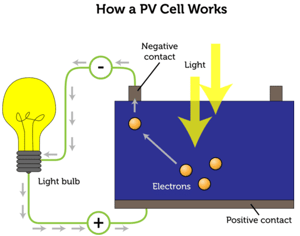 Now that it is summer, we are all eager to go out and enjoy the beautiful sunshine. Not only does the summer sun provide us long, warm days, we can also use it to reduce our carbon footprint. Solar energy can be harnessed in a couple of ways.
Now that it is summer, we are all eager to go out and enjoy the beautiful sunshine. Not only does the summer sun provide us long, warm days, we can also use it to reduce our carbon footprint. Solar energy can be harnessed in a couple of ways.
Passive solar design can capture the sun’s heat to warm enclosed spaces. This is what you experience when you enter a greenhouse. Greenhouses have transparent or semi-transparent coverings to let light in and trap in heat. We most commonly associate this with vegetable and decorative plants. But how can we use the sun’s energy to be even more advantageous to us? This is accomplished by using active solar design.
Active solar design captures the sun’s energy in little silicon cells. The National Renewable Energy Laboratory (NREL), based in Denver, CO, explains that these cells capture and convert light energy into usable energy--electricity. This process was discovered in 1954 and subsequently used to power satellites, calculators, and watches. By linking individual cells together, known as solar photovoltaic (PV) panels, we are able to produce enough energy (electricity) to power a multitude of assets. Homes, vehicles, and commercial and industrial buildings are being powered by PV panels.
In the last two decades, this technology has seen a spike in installations in both the private and public sectors. According to the Solar Energy Industries Association (SEIA), the United States has installed enough solar arrays, groups of panels, to power 15.7 million homes. With this new interest in using solar PV as a main source of electricity, SEIA notes that U.S. electrical generation has gone from 0.1% in 2010 to more than 2.5% contribution to the national grid. This has allowed prices of an average-sized residential system to drop from an average price of $40,000 to an average price of $18,000 in the same decade.
What does this mean for you? The U.S. Department of Energy (DOE) explains the first benefits realized from solar PV systems is lower monthly utility bills. Although PV systems involve a significant financial investment, you not only save money on your annual utility bills, but you will likely also increase the value of your home. Once you have integrated PV into your home or building, a multitude of appliances can work with your system to further reduce energy consumption. These products include cold climate air-source heat pumps, electric and hybrid electric-heat pump water heaters, and induction ranges just to name a few.
If you don’t want to make the investment now or are unable to install a system, you can still benefit from solar PV production by joining a community solar project. These allow many individuals to lower their electricity costs and reduce their carbon footprint.
If you are interested in learning more about solar PV systems, you can visit the following websites for more information:
https://www.nrel.gov/research/re-photovoltaics.html
https://www.seia.org/solar-industry-research-data
https://www.energy.gov/energysaver/benefits-residential-solar-electricity
https://www.energy.gov/energysaver/buying-and-making-electricity/using-solar-electricity-home
If you’d like to talk to someone about any of the content discussed above, the Energy Smart Colorado team at Walking Mountains Science Center is happy to discuss details, options, products, and contractors. Walking Mountains also provides rebates concerning solar PV, cold climate air-source heat pumps, and a variety of other energy efficiency upgrades. Call us at 970.328.8777 or email energy@walkingmountains.org to speak with an energy coach. Contact us before your project for a list of our rebates and eligibility.
What Are Solar Photovoltaic Systems and How You Can Benefit
Topics: Energy Smart, Sustainability Tips








